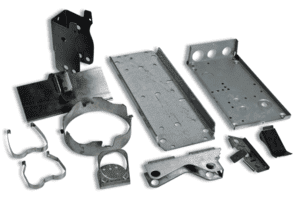ESI has built a strong reputation over the past three decades by understanding the unique challenges faced by clients in various industries. We specialize in delivering high-quality stamped metal parts while helping our customers achieve cost savings without compromising on quality. Our expertise is rooted in providing engineering solutions and advanced manufacturing services, including the use of cutting-edge automated systems. Much of our experience comes from working with automotive clients who rely on us for safety-critical components that demand precision, speed, and efficiency.
If you're looking to reduce the cost of your stamped metal parts, there are several key areas you can focus on. Here are three important factors to consider and optimize:
Material Selection
The choice of raw material plays a major role in the overall cost of metal stamping. Even small changes in material properties can affect production time and expenses. For example, harder materials require more force and energy to stamp, which increases both time and cost. By using a softer or less abrasive material—while still meeting your product’s quality requirements—you can significantly cut costs. Some materials may have similar performance characteristics but differ greatly in price, making them an attractive option for cost-conscious manufacturers.
Additionally, market conditions and evolving design standards can open up new opportunities for material substitution. If your part no longer requires certain properties due to updated specifications, switching to a more affordable alternative could be a smart move without sacrificing performance or structural integrity.
Tooling Design and Maintenance
Tooling is a critical component of the metal stamping process, and even minor adjustments can impact both cost and production efficiency. For instance, square holes often require more complex tooling and machining than round ones, increasing both time and expense. Reviewing your tooling design to simplify features where possible can help reduce complexity and maintain functionality without unnecessary costs.
Excessive wear on stamping dies often stems from intricate features like notches or sharp edges. This can lead to cracks and failure if not properly maintained. To avoid this, it's wise to either simplify such features or implement a more rigorous maintenance schedule. In cases where these features are essential, investing in higher-quality tooling or coatings can improve durability and reduce long-term costs.
Production Volume and Planning
As demand for your components increases, so does the need for larger production volumes. Higher volumes allow for better planning and optimization of designs to improve manufacturability and reduce cycle times. If you're currently using prototype designs, now is the time to explore ways to refine them for mass production while keeping costs under control.
Material and finishing costs often vary depending on the volume purchased. One effective strategy is to place blanket orders over a set period, with smaller releases scheduled weekly or monthly. This helps manage inventory and reduces per-unit costs. Additionally, reviewing complex features for simplification can improve quality control and extend the life of your tooling between maintenance cycles.
Understanding your Estimated Annual Usage (EAU) is also crucial. Based on your production frequency and volume, different tooling options—such as multi-cavity molds—can be explored to maximize efficiency and reduce costs. Adjusting the material thickness or switching to a more malleable metal can also help lower material costs and increase die life.
In some cases, unexpected volume growth may require additional tooling to meet demand. It’s important to communicate your projected volume early in the process to determine whether multiple tools will be necessary. This allows for better planning and avoids costly delays.
Quality and Cost-Effective Metal Stamping Solutions
By carefully reviewing your material choices, tooling requirements, and production volume, you can effectively reduce the cost of your stamped metal parts without compromising quality. ESI is a trusted partner in the industry, offering expert engineering and manufacturing solutions tailored to your needs.
We work closely with our clients throughout the entire process to ensure that their stamped parts meet all specifications and industry standards while remaining cost-effective. Whether you're looking to optimize existing designs or streamline new ones, we're here to help. Contact the ESI team today and request a personalized quote to get started.
The vauum forming light box adopts thermoforming processing technology, and is generally made of acrylic PMMA raw materials. Due to the stable quality of acrylic, its products have characteristics such as good transparency, clear farsightedness, high compressive strength, over ten years of non fading, and brightness that cannot be compared to other light boxes and metal characters. It is the preferred product for businesses with sustainable operation and strong strength.
Main application fields of vacuum forming light box:
1. Construction class, such as: window, soundproof door wall, lighting cover, solar collector, telephone booth.
2. Advertisement display class, such as: lamp box, signboard, indicator, display rack, ball type cover, guide card.
3. Industrial products, such as the panel of instrument and instrument, machine cover and flowmeter.
4. Lighting types, such as: solar lampshades, various shape lampshades used in environmental purification equipment.
5. Civil class, such as: bathroom equipment, makeup stand, photo frame, item rack, gift, souvenir, cold chair, seat back, candy box, reference frame, food cover.
6. Medical class, such as baby incubator, kit, thermostat, operating cabinet.
7. Special purpose classes such as: aircraft, yacht and car Windows and windshield, submarine and trench with periscope.
Vacuum Forming Light Box,Vacuum Forming Lamp Cover,Vacuum Forming Advertisement,Thermoforming Light Box
Dongguan Yiyongli Industrial Co.,Ltd. , https://www.absthermoforming.com

Comments are closed